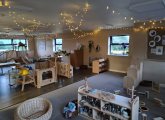As everyone involved in the provision of early years care and education is well aware, recent years have seen a dramatic series of changes to the services the sector provides, and the expectations placed upon them.
From the implementation of the revised Early Years Foundation Stage (EYFS) framework in September 2012, through to last year’s initiative to provide funding for disadvantaged two-year-olds and this year’s proposals to extend the Pupil Premium to underprivileged three- and four-year-olds, these are certainly exciting times for those dedicated professionals caring for the nation’s preschool population. Oh yes… and there is a baby boom currently under way and an election on the horizon, with every party likely to be putting education and early years provision high up their political agendas.
Whichever party wins and whatever policies they implement, however, there will be no change to the fundamental principles that the EYFS has embedded: that every child deserves the best possible start in life, including support to prepare them for school, help them fulfil their potential, and have fun along the way.
Sir Winston Churchill once said that, “We shape our buildings and then they shape us.” There is a growing body of evidence that the buildings and environment in which children are nurtured play a fundamental role in their physical health, and in the development of their cognitive, social and emotional skills. More specifically, exposure to natural daylight, both directly through playing outside and indirectly via well-lit interiors, is now known to have a significant effect on a child’s physical and mental wellbeing.
Daylight is good for our physical health. It increases the production of vitamin D, helps to regulate our circadian rhythms and sleep patterns, and improves visibility, making it possible for us to perform tasks faster and more accurately. Mentally, it is known to boost the mood of children and staff alike. Perhaps even more importantly, a good blast of fresh air and sunlight improves behaviour, particularly in regard to sociability and concentration.
Conversely, prolonged exposure to artificial lighting is associated with protracted, high levels of cortisone, the hormone associated with stress. Amongst the negative effects of an extended elevation of cortisone levels are raised blood pressure, a depressed immune system and impaired cognitive performance.
Dealing first with the issue of outdoor play, natural environments are uniquely engaging, stimulating and life-enhancing. They allow children to reach new depths of understanding about themselves, their abilities and their relationship with the world around them. Exposure to nature has been found to enhance children’s concentration, self-discipline and behaviour. Furthermore, the less children play outdoors, the less they learn to cope with the risks and challenges they will face as they grow into adulthood. If you are interested in learning more about the importance of nature in children’s lives, you might want to peruse a white paper, commissioned by eco-nursery provider The Learning Escape, entitled ‘The Outdoor Environment’.
A study conducted by Heschong and Mahone, in the US in the late 1990s and early 2000s, found that school children taught in classrooms predominantly lit naturally performed significantly better in standard maths and literacy tests than those learning in an artificially lit environment. A more recent study in early years facilities has shown a similar improvement in preschool children’s cognitive development. Furthermore, the inclusion of full-length windows in a nursery building’s design helps to connect its occupants to the natural world outside.
The EYFS guidelines recommend that, in an ideal world, children should have access to free-flow play. Unfortunately this is not always practicable if an early years setting is part of a larger building and sharing its outside space with other (often larger and more boisterous) occupants, or if visibility from inside to out is restricted. So if you are considering options for building a new nursery, it is worth considering a standalone building with its own fenced, secure outside play space directly within the sight-line of staff inside the building. Children can then be free to flow from indoors to outside as they explore their world safely through play.
Here are a few comments from some eco-nursery customers of The Learning Escape, talking about the positive impact their new buildings have had upon children, staff and parents alike:
“The nursery children now have better access to their outdoor classroom area. We have seen a big improvement in their behaviour and they are much calmer, something that we think may be due to the natural light they have, which was not available in the previous room.”
Alison Price, Headteacher, St Fagan’s
“We have a beautiful, multi-purpose room which has just blended into our environment. Parents and families love coming into this space, which has also provided a lovely office and working environment for our staff. It is also a great place for meetings and training, and our parents find it a particularly calming space.”
Christine McCrone, Headteacher, Lord Street Primary
“The nursery’s location in the school grounds has helped us incorporate free-flow play into our everyday teaching, with the full-length doors and windows letting children enjoy the natural scenery from both in or outside of the classroom. There is superb natural light throughout the building, which reduces the need for artificial lighting and helps emphasise the connection between the classroom and the natural surroundings.”
Sue Bladen, Business Manager, Pitmaston Primary School

Eco activities for your early years setting
Editors picks

Hygge in the early years – What it is and how to do it
Editors picks
